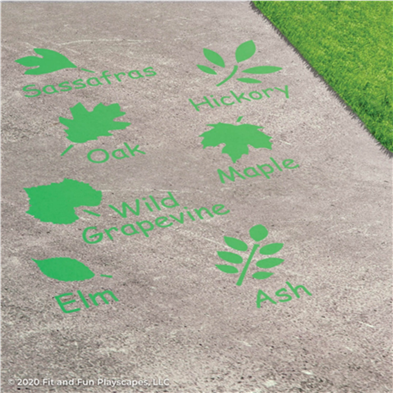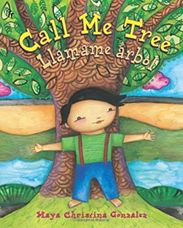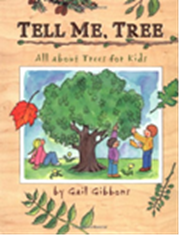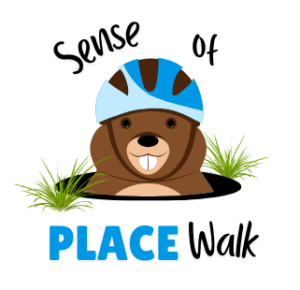 Station 3 – Nature
Station 3 – Nature
LOOK ALL AROUND YOU!
Look around you! Nature is everywhere! We live in a very unique climate in the Pacific Northwest.
The Pacific Northwest has a cool, wet climate, which is perfect to grow thick forests. Some of the biggest trees in the world can be found here! The World’s Largest Western Red Cedar, Sitka Spruce, Yellow Cader, Mountain Hemlock and Western Hemlock are found near Lake Quinault, which is about 2 hours to the west from Garfield Elementary School. Our temperate rainforests are some of the rainiest places in the world, too! Temperate rainforests are in the temperate zone (between the Tropic of Cancer and the arctic circle for us) and receive heavy rainfall.

Can you see the stenciled leaves on the ground? Could they be from any trees you would find here, in the Pacific Northwest naturally?
Sassafras trees DO NOT grow in Washington. They can be found throughout most of the eastern United States and west of the Mississippi River into Louisiana, Missouri, Arkansas, and eastern Texas and Oklahoma.
Oak trees DO grow in Washington. The Oregon White Oak is the only native species, stretching from southern California to southwestern British Columbia.
Hickory trees DO grow in Washington. The King Nut Hickory is naturally found in Idaho or inland Oregon or Washington.
Wild Grapevines DO grow in Washington. However, grape vines are invasive. They can be deadly, if left to overtake a tree canopy. They block out light, reducing the photosynthesis and weakening the tree.
Maple trees DO grow in Washington. Check out the deciduous trees list, below.
Elm trees DO grow in Washington. We still have four American Elm trees in Seattle which are George Washington Elms because they are descended from one of the original trees at Cambridge Common, planted over 250 years ago!
Ash trees DO grow in Washington. The Oregon Ash tree grows along the shores of Puget Sound, in the western Cascade Range, and along the southwestern coast, but not in the Olympic Mountains
Sensory Activity!
When deciduous leaves fall in the Fall, it’s time to get some outdoor exercise and fun and rake them up! Deciduous trees have leaves that fall off each year. Coniferous trees’ leaves stay on. Can you see some deciduous trees around you. Can you see any coniferous trees? Do you know their names?
Did you know there are many sensory benefits for children raking leaves? According to Timothy D. Davis PhD. CAPE, (www.fitandfunplayscapes.com/blogs/sensory-benefits-raking-leaves) there are tactical, balance, and proprioception (the body’s ability to sense movement and position in space). Raking leaves requires bodies to stand and balance and twist! Tactically, children leave to hold the rake and apply the right amount of pressure to move leaves around. And running and jumping into freshly mounded leaves is a skill to land in the right space!
Deciduous TREES You Can Find Near Us
Red Alder and Sitka Alder (Birch Family)
Pacific Dogwood (Dogwood Family)
Bigleaf Maple, Douglas Maple, and Vine Maple (Maple Family)
Bitter Cherry and Wild Crabapple (Rose Family)
Black Cottonwood (Willow Family)
coniferous TREES you can find near us
Douglas-fir, Grand Fir, Noble Fir, Pacific Silver Fir, Subalpine Fir, Mountain Hemlock, Western Hemlock, Lodgepole Pine, Ponderosa Pine, Whitebark Pine, Western White Pine, Englemann Spruce, and Sitka Spruce (Pine Family)
Alaska Yellow Cedar and Western Red Cedar (Cypress Family)
Western Yew (Yew Family)
Art Activities!
Go on a nature walk to collect leaves for a fun project exploring colors, shapes, and textures. www.pbs.org/parents/crafts-and-experiments/make-leaf-observations-on-an-autumn-nature-walk
Bring paper and crayons on your walk and take bark and leaf rubbings. www.pbs.org/parents/crafts-and-experiments/make-leaf-and-bark-rubbings
Use those same collected leaves to study plant patterns. www.pbs.org/parents/crafts-and-experiments/plant-patterns
Print this Plant Puzzle game with plant parts and a tree reference sheet. You can play with someone else to see how yours drawings are similar and different! www.pbs.org/parents/crafts-and-experiments/plant-puzzles
Here are some other fun activities to help our local birds and bees!
Make Window Decals to Help Migrating Birds www.pbs.org/parents/crafts-and-experiments/make-window-decals-to-help-migrating-birds
Mason bees are some of the best pollinators! Make a Wild Bee Hotel to help house these essential insects www.pbs.org/parents/crafts-and-experiments/make-a-wild-bee-hotel
Books To Read Together

Call Me Tree / Llamame Arbol by Maya Christina Gonzalez
In this spare, lyrically written story, we join a child on a journey of self-discovery. Finding a way to grow from the inside out, just like a tree, the child develops as an individual comfortable in the natural world and in relationships with others. The child begins Within / The deep dark earth, like a seed, ready to grow and then dream and reach out to the world. Soon the child discovers birds and the sky and other children: Trees and trees / Just like me! Each is different too. The child embraces them all because All trees have roots/ All trees belong. Maya Christina Gonzalez once again combines her talents as an artist and a storyteller to craft a gentle, empowering story about belonging, connecting with nature, and becoming your fullest self. Young readers will be inspired to dream and reach, reach and dream . . . and to be as free and unique as trees.
Find the Library book HERE.

Tell Me, Tree by Gail Gibbons
Learn all about trees, leaves, and their inner workings in this colorful, favorite picture book by award-winning nonfiction author and illustrator Gail Gibbons.
Trees shelter and surround us. Their leaves offer shade from the hot summer sun. In autumn, they dazzle us with color. In winter, they stand tall against a cold and snowy background. Trees may look solitary, but each one is teeming with life.
Tell Me, Tree is a child’s guide to the wide variety of trees that surround us, including how to identify them the structure of trees, with cut-away illustrations and labels. The book also includes an explanation of photosynthesis and a special section on how to make a tree identification book of your own. Tell Me, Tree, is the perfect read for Earth Day and Arbor Day, and for nature-lovers year-round.
Find the Library book HERE.
 Station 3 – Nature
Station 3 – Nature